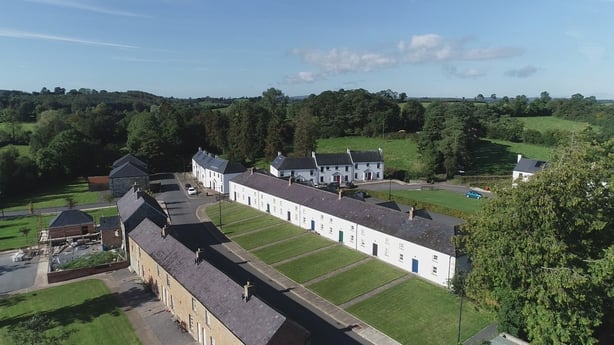Mullan's population was reduced to one during the Troubles, now the village faces a new fight for survival
High politics and low insults have characterised much of the Brexit story since 2016.
Today marks 1,188 days since the referendum. That's three years and two British Prime Ministers ago.
Far away from Westminster, Mullan is a tiny village in Monaghan. It's just a few hundred yards from the Northern Ireland border which is marked by the Blackwater River.
A small bridge called 'Ballagh' bridge crosses what will soon be the frontier between the EU and the UK.
The history of this village illustrates the story of the Irish border.
Watch Conor McMorrow's video report from Mullan on Prime Time on the RTÉ Player
Mullan on the Monaghan-Tyrone boundary grew up around a Victorian-era flax mill.
Workers lived in adjoining houses in a bustling industrial village. Through time, the flax mill was replaced by a shoe factory that produced the aptly named 'Border Brand Shoes'.
After it became less sustainable to produce shoes in Ireland, the industry declined in the 1970s and the factory closed in the 1980s.
But it was the Northern Ireland Troubles that had the most profound effect on this village. A peaceful place, it was decimated after the security forces in the North closed Ballagh bridge in 1973.
The British road closure policy was partly motivated by concerns that the Unionist community in Northern Ireland was more vulnerable to IRA attacks as the Border was too porous.
So the British army closed a lot of border roads. Some were blown up leaving huge craters in them. Others had large concrete barriers put in place as roadblocks.

By closing or destroying back roads like the road out of Mullan, traffic could be funneled through military checkpoints that were in place on major roads.
Overnight, the village that housed almost 200 people in the good times became a "dead end". Marginalised and segregated by the closure of the road, Mullan's population plummeted. Just one person was left living there.
91-year-old Seamus Mulligan lives in the house he was born into in Mullan. He was the sole resident in the village for 15 years.
Describing the deserted village he said: "You could sit in the middle of the road all day and you wouldn't have to move."
Houses in Mullan fell into disrepair and the once proud village appeared to be in terminal decline.
In the early 1990s, groups of people from communities along the Border started a campaign to reopen roads and build makeshift bridges at various remote border crossings. They would meet up, mostly on Sunday afternoons, to remove concrete barriers or fill in craters to temporarily reopen the roads. Security forces would quickly close them down again.
Victor Watterson, a former employee of the defunct shoe factory in Mullan, was a man ahead of his time.
In the late 1980s he bought a camcorder and started recording life as it unfolded around him.
As his neighbours came together with a large digger to tear down the concrete barriers on various border crossings, Victor went along with his camera and recorded the work of the groups known as the "Border Busters".
In January 1990, a group of local people gathered and removed the large concrete structures that blocked off Ballagh bridge beside Mullan.
Mr Watterson caught the scenes on camera and kept them on a VHS tape, in a dusty old box.
"Locals say they would "hate" to see a return to a hard border as the village was literally a dead end during the Troubles"
Tonight Prime Time will broadcast the events of that day on TV for the first time. They show a community coming together to tear down the border.
As they do it, two large helicopters carrying RUC personnel land in a field on the northern side of the bridge. Plastic bullets are fired into the crowd. One 19-year-old Tyrone man is hit in the face and later taken to hospital for treatment for his injuries.
Shocked by the events of that day, Mr Watterson stopped recording the Border Busters.
His old camcorder recordings are now a relic from the past. A blunt reminder of how reinforcing borders isolated communities like Mullan.
A few years after Mr Watterson recorded the border walls being torn down, the Peace Process started to take hold. After the Good Friday Agreement, border crossings including Ballagh Bridge were gradually re-opened.
At the turn of the century, the entire village of Mullan went up for sale. Seamus Mulligan was its sole occupant at the time.
Local businessman Michael Treanor bought it in 2002 and renovated the whole village into a modern living space.
With the road re-opened, Mullan became an attractive place to live again and it has been rejuvenated with young families moving in.
Ten years ago Mr Treanor's son Mike and his wife Edel, started up a light manufacturing plant in the old mill building.
Mullan Lighting now employs over 60 people and exports bespoke designer lights to 55 countries.
To mitigate against the threat of a hard Brexit, the company is currently focusing on developing its overseas markets beyond the UK.
Business aside, the threat of a hard border threatens the very fabric of life in the revitalised village.
Locals say they would "hate" to see a return to a hard border as the village was literally a dead end during the Troubles.
Victor Watterson's old VHS tape is almost three decades old. It shows an isolated and angry community attempting to tear down borders.
With one eye on Westminster, people in places like Mullan hope that those scenes never return.
Grainy relics from the past on an old VHS tape, unwanted in the future.
Watch Conor McMorrow's video report from Mullan on Prime Time on the RTÉ Player.
Watch Conor McMorrow's video report from Mullan on Prime Time on the RTÉ Player.
Comments
Post a Comment